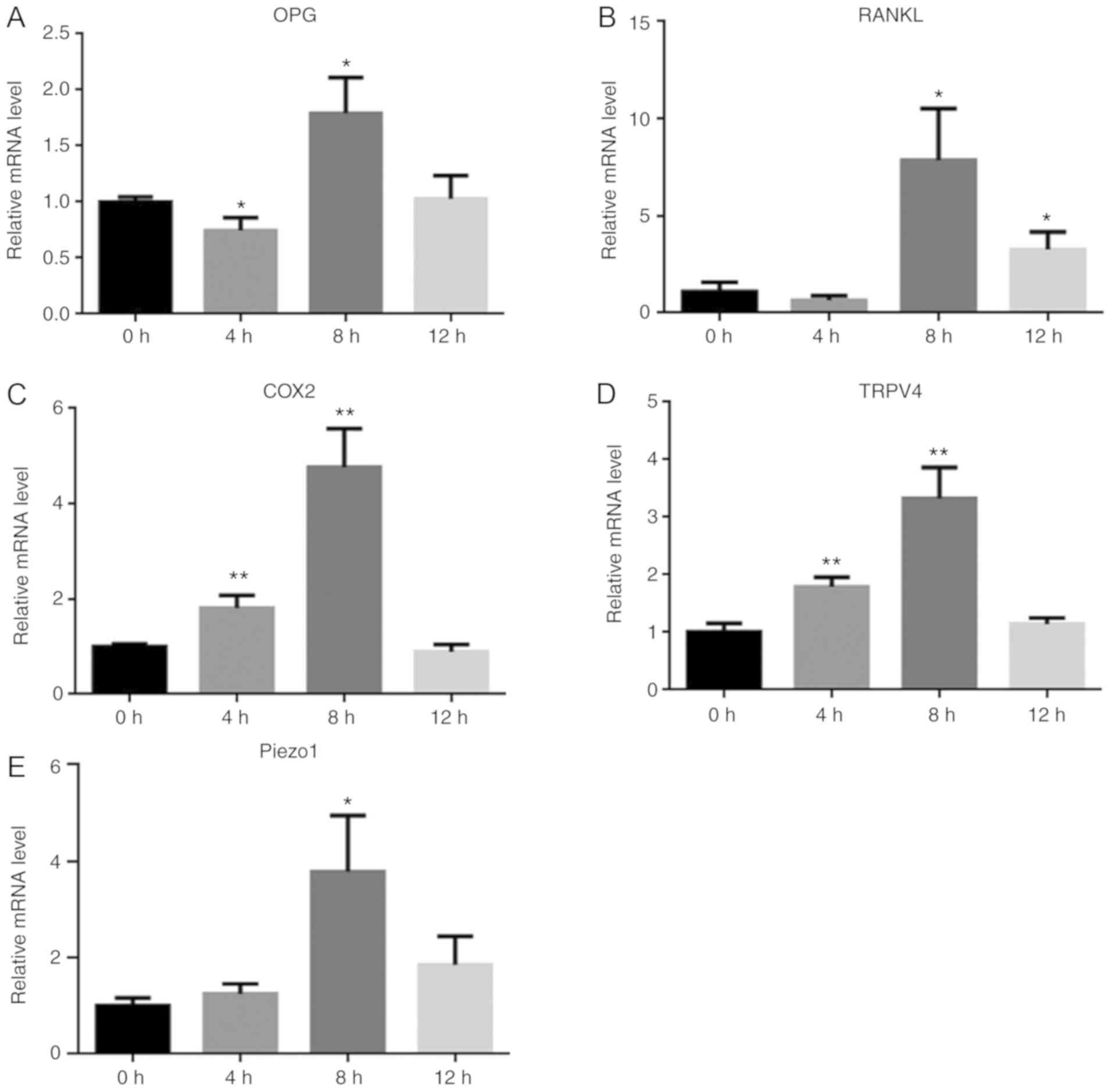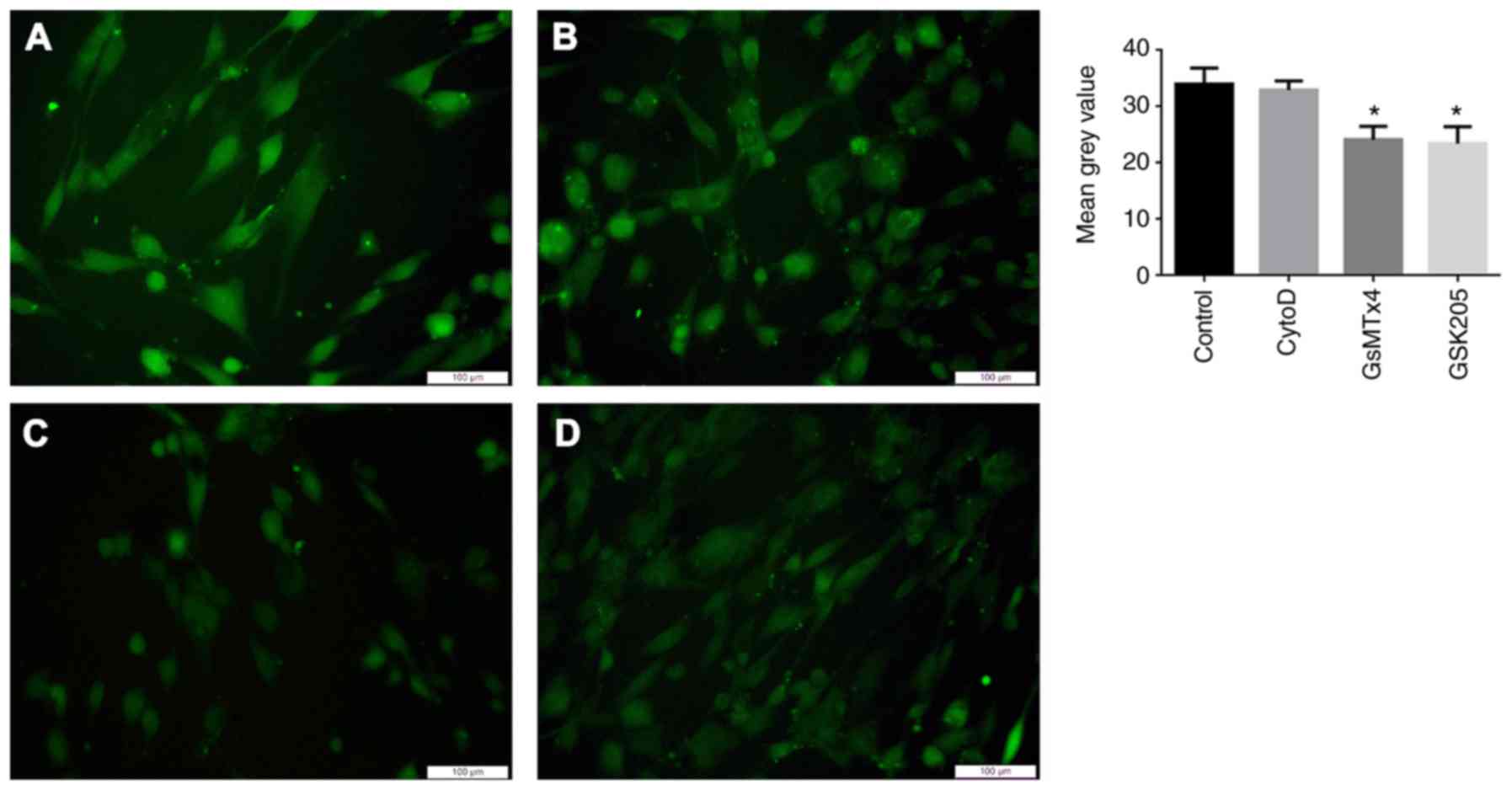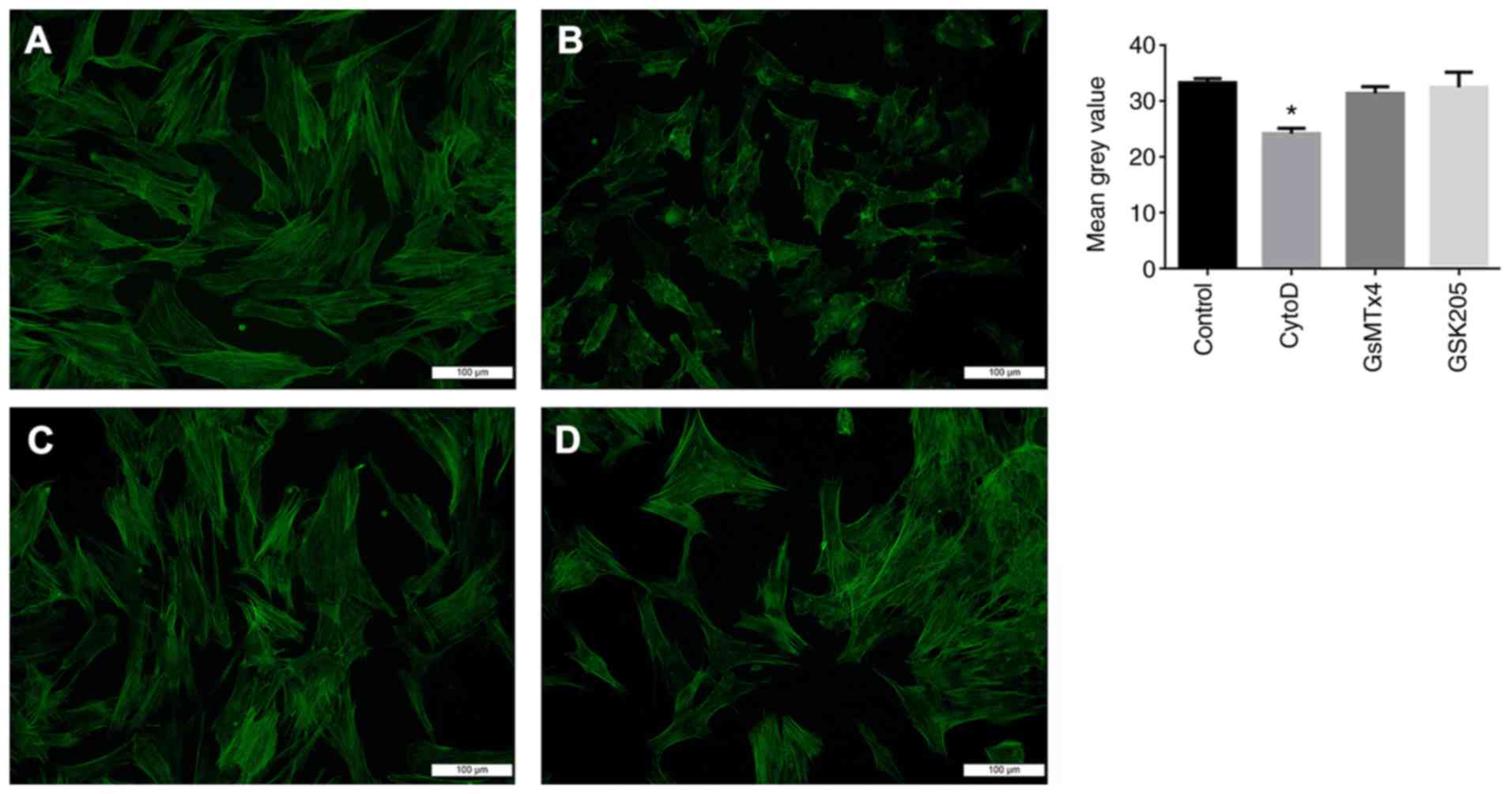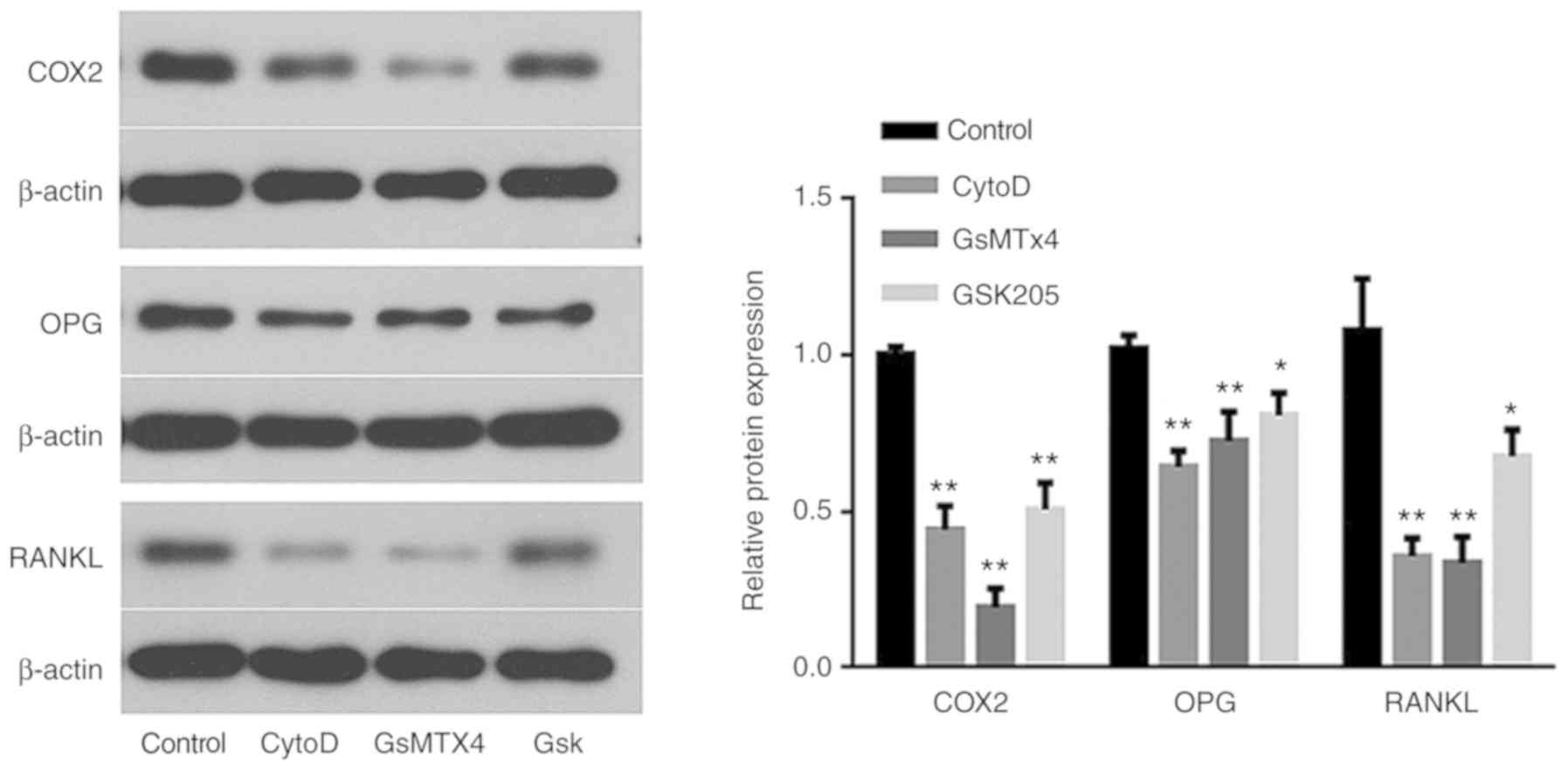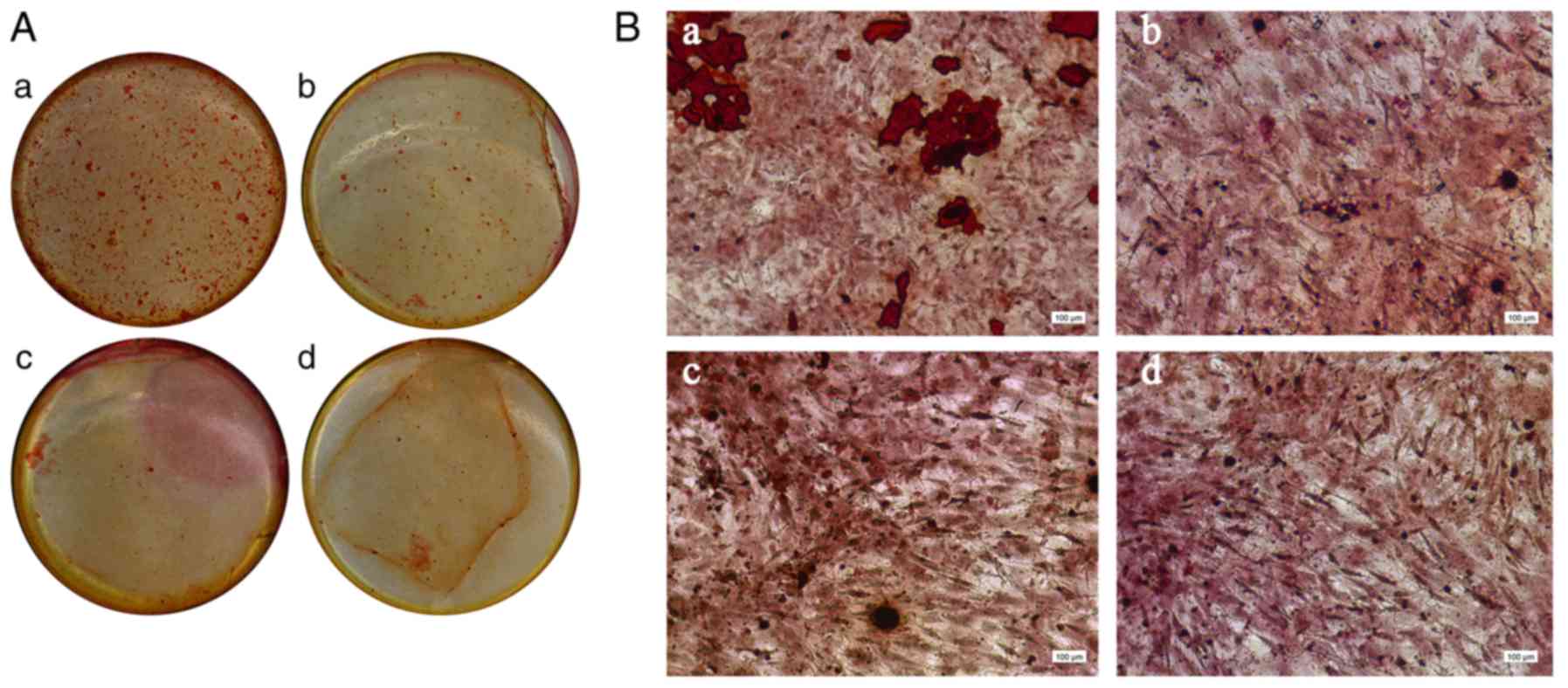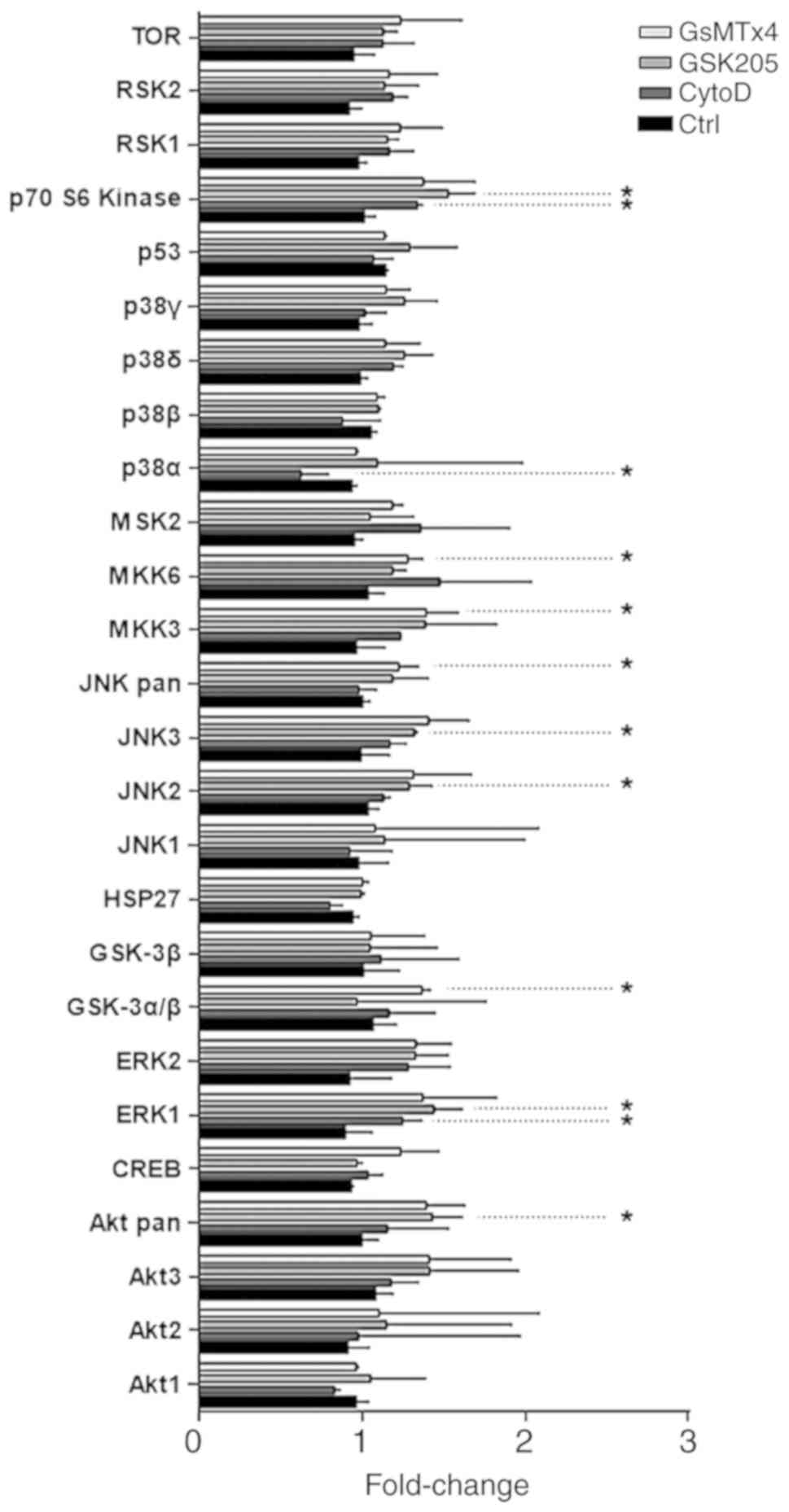|
1
|
Proffit WR, Fields HW and Sarver DM:
Contemporary Orthodontics. 5th. Mosby; St. Louis: 2012
|
|
2
|
Chang M, Lin H, Fu H, Wang B, Han G and
Fan M: MicroRNA-195-5p regulates osteogenic differentiation of
periodontal ligament cells under mechanical loading. J Cell
Physiol. 232:3762–3774. 2017. View Article : Google Scholar : PubMed/NCBI
|
|
3
|
Feng L, Zhang Y, Kou X, Yang R, Liu D,
Wang X, Song Y, Cao H, He D, Gan Y and Zhou Y: Cadherin-11
modulates cell morphology and collagen synthesis in periodontal
ligament cells under mechanical stress. Angle Orthod. 87:193–199.
2017. View Article : Google Scholar : PubMed/NCBI
|
|
4
|
Zhang H and Zhang D: Effects of
periodontal ligament cells on alveolar bone metabolism under the
action of force and inflammatory factors and its molecular
mechanisms. Zhongguo Yi Xue Ke Xue Yuan Xue Bao. 39:432–437.
2017.PubMed/NCBI
|
|
5
|
Li Y, Jacox LA, Little SH and Ko CC:
Orthodontic tooth movement: The biology and clinical implications.
Kaohsiung J Med Sci. 34:207–214. 2018. View Article : Google Scholar : PubMed/NCBI
|
|
6
|
Roca-Cusachs P, del Rio A, Puklin-Faucher
E, Gauthier NC, Biais N and Sheetz MP: Integrin-dependent force
transmission to the extracellular matrix by alpha-actinin triggers
adhesion maturation. Proc Natl Acad Sci USA. 110:E1361–E1370. 2013.
View Article : Google Scholar : PubMed/NCBI
|
|
7
|
Zhou J, Aponte-Santamaria C, Sturm S,
Bullerjahn JT, Bronowska A and Grater F: Mechanism of focal
adhesion kinase mechanosensing. PLoS Comput Biol. 11:e10045932015.
View Article : Google Scholar : PubMed/NCBI
|
|
8
|
Jin Y, Li J, Wang Y, Ye R, Feng X, Jing Z
and Zhao Z: Functional role of mechanosensitive ion channel Piezo1
in human periodontal ligament cells. Angle Orthod. 85:87–94. 2015.
View Article : Google Scholar : PubMed/NCBI
|
|
9
|
Lu J, Lee YK, Ran X, Lai WH, Li RA, Keung
W, Tse K, Tse HF and Yao X: An abnormal TRPV4-related cytosolic
Ca2+ rise in response to uniaxial stretch in induced
pluripotent stem cells-derived cardiomyocytes from dilated
cardiomyopathy patients. Biochim Biophys Acta Mol Basis Dis.
1863:2964–2972. 2017. View Article : Google Scholar : PubMed/NCBI
|
|
10
|
Cox CD, Bae C, Ziegler L, Hartley S,
Nikolova-Krstevski V, Rohde PR, Ng CA, Sachs F, Gottlieb PA and
Martinac B: Removal of the mechanoprotective influence of the
cytoskeleton reveals PIEZO1 is gated by bilayer tension. Nat
Commun. 7:103662016. View Article : Google Scholar : PubMed/NCBI
|
|
11
|
Coste B, Mathur J, Schmidt M, Earley TJ,
Ranade S, Petrus MJ, Dubin AE and Patapoutian A: Piezo1 and Piezo2
are essential components of distinct mechanically activated cation
channels. Science. 330:55–60. 2010. View Article : Google Scholar : PubMed/NCBI
|
|
12
|
Ge J, Li W, Zhao Q, Li N, Chen M, Zhi P,
Li R, Gao N, Xiao B and Yang M: Architecture of the mammalian
mechanosensitive Piezo1 channel. Nature. 527:64–69. 2015.
View Article : Google Scholar : PubMed/NCBI
|
|
13
|
Strotmann R, Harteneck C, Nunnenmacher K,
Schultz G and Plant TD: OTRPC4, a nonselective cation channel that
confers sensitivity to extracellular osmolarity. Nat Cell Biol.
2:695–702. 2000. View
Article : Google Scholar : PubMed/NCBI
|
|
14
|
Güler AD, Lee H, Iida T, Shimizu I,
Tominaga M and Caterina M: Heat-evoked activation of the ion
channel, TRPV4. J Neurosci. 22:6408–6414. 2002. View Article : Google Scholar : PubMed/NCBI
|
|
15
|
Gao X, Wu L and O'Neil RG:
Temperature-modulated diversity of TRPV4 channel gating: Activation
by physical stresses and phorbol ester derivatives through protein
kinase C-dependent and -independent pathways. J Biol Chem.
278:27129–27137. 2003. View Article : Google Scholar : PubMed/NCBI
|
|
16
|
Danielczok JG, Terriac E, Hertz L,
Petkova-Kirova P, Lautenschlager F, Laschke MW and Kaestner L: Red
blood cell passage of small capillaries is associated with
transient Ca2+-mediated adaptations. Front Physiol.
8:9792017. View Article : Google Scholar : PubMed/NCBI
|
|
17
|
Servin-Vences MR, Richardson J, Lewin GR
and Poole K: Mechanoelectrical transduction in chondrocytes. Clin
Exp Pharmacol Physiol. 45:481–488. 2018. View Article : Google Scholar : PubMed/NCBI
|
|
18
|
Sugimoto A, Miyazaki A, Kawarabayashi K,
Shono M, Akazawa Y, Hasegawa T, Ueda-Yamaguchi K, Kitamura T,
Yoshizaki K, Fukumoto S and Iwamoto T: Piezo type mechanosensitive
ion channel component 1 functions as a regulator of the cell fate
determination of mesenchymal stem cells. Sci Rep. 7:176962017.
View Article : Google Scholar : PubMed/NCBI
|
|
19
|
Blythe NM, Muraki K, Ludlow MJ,
Stylianidis V, Gilbert HTJ, Evans EL, Cuthbertson K, Foster R,
Swift J, Li J, et al: Mechanically activated Piezo1 channels of
cardiac fibroblasts stimulate p38 mitogen-activated protein kinase
activity and interleukin-6 secretion. J Biol Chem. 294:17395–17408.
2019. View Article : Google Scholar : PubMed/NCBI
|
|
20
|
Li XF, Zhang Z, Li XD, Wang TB and Zhang
HN: Mechanism of the Piezo1 protein-induced apoptosis of the
chondrocytes through the MAPK/ERK1/2 signal pathway. Zhonghua Yi
Xue Za Zhi. 96:2472–2477. 2016.(In Chinese). PubMed/NCBI
|
|
21
|
Liang J, Huang B, Yuan G, Chen Y, Liang F,
Zeng H, Zheng S, Cao L, Geng D and Zhou S: Stretch-activated
channel Piezo1 is up-regulated in failure heart and cardiomyocyte
stimulated by AngII. Am J Transl Res. 9:2945–2955. 2017.PubMed/NCBI
|
|
22
|
Qu YJ, Zhang X, Fan ZZ, Huai J, Teng YB,
Zhang Y and Yue SW: Effect of TRPV4-p38 MAPK pathway on neuropathic
pain in rats with chronic compression of the dorsal root ganglion.
Biomed Res Int. 2016:69789232016. View Article : Google Scholar : PubMed/NCBI
|
|
23
|
Livak KJ and Schmittgen TD: Analysis of
relative gene expression data using real-time quantitative PCR and
the 2(-Delta Delta C(T)) method. Methods. 25:402–408. 2001.
View Article : Google Scholar : PubMed/NCBI
|
|
24
|
Yang Z, Tan S, Shen Y, Chen R, Wu C, Xu Y,
Song Z and Fu Q: Inhibition of FSS-induced actin cytoskeleton
reorganization by silencing LIMK2 gene increases the
mechanosensitivity of primary osteoblasts. Bone. 74:182–190. 2015.
View Article : Google Scholar : PubMed/NCBI
|
|
25
|
Kanzaki H, Chiba M, Shimizu Y and Mitani
H: Periodontal ligament cells under mechanical stress induce
osteoclastogenesis by receptor activator of nuclear factor kappaB
ligand up-regulation via prostaglandin E2 synthesis. J Bone Miner
Res. 17:210–220. 2002. View Article : Google Scholar : PubMed/NCBI
|
|
26
|
Boyce BF and Xing L: The RANKL/RANK/OPG
pathway. Curr Osteoporos Rep. 5:98–104. 2007. View Article : Google Scholar : PubMed/NCBI
|
|
27
|
Garlet TP, Coelho U, Silva JS and Garlet
GP: Cytokine expression pattern in compression and tension sides of
the periodontal ligament during orthodontic tooth movement in
humans. Eur J Oral Sci. 115:355–362. 2007. View Article : Google Scholar : PubMed/NCBI
|
|
28
|
Kim T, Handa A, Iida J and Yoshida S:
RANKL expression in rat periodontal ligament subjected to a
continuous orthodontic force. Arch Oral Biol. 52:244–250. 2007.
View Article : Google Scholar : PubMed/NCBI
|
|
29
|
Kanjanamekanant K, Luckprom P and Pavasant
P: Mechanical stress-induced interleukin-1beta expression through
adenosine triphosphate/P2X7 receptor activation in human
periodontal ligament cells. J Periodontal Res. 48:169–176. 2013.
View Article : Google Scholar : PubMed/NCBI
|
|
30
|
Fu HD, Wang BK, Wan ZQ, Lin H, Chang ML
and Han GL: Wnt5a mediated canonical Wnt signaling pathway
activation in orthodontic tooth movement: Possible role in the
tension force-induced bone formation. J Mol Histol. 47:455–466.
2016. View Article : Google Scholar : PubMed/NCBI
|
|
31
|
Alhashimi N, Frithiof L, Brudvik P and
Bakhiet M: CD40-CD40L expression during orthodontic tooth movement
in rats. Angle Orthod. 74:100–105. 2004.PubMed/NCBI
|
|
32
|
Grieve WG 3rd, Johnson GK, Moore RN,
Reinhardt RA and DuBois LM: Prostaglandin E (PGE) and interleukin-1
beta (IL-1 beta) levels in gingival crevicular fluid during human
orthodontic tooth movement. Am J Orthod Dentofacial Orthop.
105:369–374. 1994. View Article : Google Scholar : PubMed/NCBI
|
|
33
|
Dougall WC: Molecular pathways:
Osteoclast-dependent and osteoclast-independent roles of the
RANKL/RANK/OPG pathway in tumorigenesis and metastasis. Clin Cancer
Res. 18:326–335. 2012. View Article : Google Scholar : PubMed/NCBI
|
|
34
|
Sachs F: Mechanical transduction by ion
channels: A cautionary tale. World J Neurol. 5:74–87. 2015.
View Article : Google Scholar : PubMed/NCBI
|
|
35
|
Ingber DE: Tensegrity-based mechanosensing
from macro to micro. Prog Biophys Mol Biol. 97:163–179. 2008.
View Article : Google Scholar : PubMed/NCBI
|
|
36
|
Li J, Chen G, Zheng L, Luo S and Zhao Z:
Osteoblast cytoskeletal modulation in response to compressive
stress at physiological levels. Mol Cell Biochem. 304:45–52. 2007.
View Article : Google Scholar : PubMed/NCBI
|
|
37
|
Mammoto A and Ingber DE: Cytoskeletal
control of growth and cell fate switching. Curr Opin Cell Biol.
21:864–870. 2009. View Article : Google Scholar : PubMed/NCBI
|
|
38
|
Son GY, Yang YM, Park WS, Chang I and Shin
DM: Hypotonic stress induces RANKL via transient receptor potential
melastatin 3 (TRPM3) and vaniloid 4 (TRPV4) in human PDL cells. J
Dent Res. 94:473–481. 2015. View Article : Google Scholar : PubMed/NCBI
|
|
39
|
Choquet D, Felsenfeld DP and Sheetz MP:
Extracellular matrix rigidity causes strengthening of
integrin-cytoskeleton linkages. Cell. 88:39–48. 1997. View Article : Google Scholar : PubMed/NCBI
|
|
40
|
Matthews BD, Thodeti CK, Tytell JD,
Mammoto A, Overby DR and Ingber DE: Ultra-rapid activation of TRPV4
ion channels by mechanical forces applied to cell surface beta1
integrins. Integr Biol (Camb). 2:435–442. 2010. View Article : Google Scholar : PubMed/NCBI
|
|
41
|
Berridge MJ, Bootman MD and Lipp P:
Calcium-a life and death signal. Nature. 395:645–648. 1998.
View Article : Google Scholar : PubMed/NCBI
|
|
42
|
Berridge MJ, Lipp P and Bootman MD: The
versatility and universality of calcium signalling. Nat Rev Mol
Cell Biol. 1:11–21. 2000. View Article : Google Scholar : PubMed/NCBI
|
|
43
|
Benavides Damm T and Egli M: Calcium's
role in mechanotransduction during muscle development. Cell Physiol
Biochem. 33:249–272. 2014. View Article : Google Scholar : PubMed/NCBI
|
|
44
|
Strotmann R, Schultz G and Plant TD:
Ca2+-dependent potentiation of the nonselective cation channel
TRPV4 is mediated by a C-terminal calmodulin binding site. J Biol
Chem. 278:26541–26549. 2003. View Article : Google Scholar : PubMed/NCBI
|
|
45
|
Ishida T, Peterson TE, Kovach NL and Berk
BC: MAP kinase activation by flow in endothelial cells. Role of
beta 1 integrins and tyrosine kinases. Circ Res. 79:310–316. 1996.
View Article : Google Scholar : PubMed/NCBI
|
|
46
|
Kippenberger S, Bernd A, Loitsch S,
Guschel M, Muller J, Bereiter-Hahn J and Kaufmann R: Signaling of
mechanical stretch in human keratinocytes via MAP kinases. J Invest
Dermatol. 114:408–412. 2000. View Article : Google Scholar : PubMed/NCBI
|
|
47
|
Yamazaki T, Komuro I, Shiojima I and
Yazaki Y: The molecular mechanism of cardiac hypertrophy and
failure. Ann N Y Acad Sci. 874:38–48. 1999. View Article : Google Scholar : PubMed/NCBI
|
|
48
|
Wang Q, Zhou Y, Wang X and Evers BM:
Glycogen synthase kinase-3 is a negative regulator of extracellular
signal-regulated kinase. Oncogene. 25:43–50. 2006. View Article : Google Scholar : PubMed/NCBI
|
|
49
|
Liu S, Fang X, Hall H, Yu S, Smith D, Lu
Z, Fang D, Liu J, Stephens LC, Woodgett JR and Mills GB: Homozygous
deletion of glycogen synthase kinase 3beta bypasses senescence
allowing Ras transformation of primary murine fibroblasts. Proc
Natl Acad Sci USA. 105:5248–5253. 2008. View Article : Google Scholar : PubMed/NCBI
|
|
50
|
Götschel F, Kern C, Lang S, Sparna T,
Markmann C, Schwager J, McNelly S, von Weizsäcker F, Laufer S,
Hecht A and Merfort I: Inhibition of GSK3 differentially modulates
NF-kappaB, CREB, AP-1 and beta-catenin signaling in hepatocytes,
but fails to promote TNF-alpha-induced apoptosis. Exp Cell Res.
314:1351–1366. 2008. View Article : Google Scholar : PubMed/NCBI
|
|
51
|
Terada Y, Nakashima O, Inoshita S,
Kuwahara M, Sasaki S and Marumo F: Mitogen-activated protein kinase
cascade and transcription factors: The opposite role of MKK3/6-p38K
and MKK1-MAPK. Nephrol Dial Transplant. 14 (Suppl 1):S45–S47. 1999.
View Article : Google Scholar
|
|
52
|
Papadopoulou A, Todaro A, Eliades T and
Kletsas D: Effect of hyperglycaemic conditions on the response of
human periodontal ligament fibroblasts to mechanical stretching.
Eur J Orthod. 41:583–590. 2019. View Article : Google Scholar : PubMed/NCBI
|
|
53
|
Danciu TE, Adam RM, Naruse K, Freeman MR
and Hauschka PV: Calcium regulates the PI3K-Akt pathway in
stretched osteoblasts. FEBS Lett. 536:193–197. 2003. View Article : Google Scholar : PubMed/NCBI
|
|
54
|
Divolis G, Mavroeidi P, Mavrofrydi O and
Papazafiri P: Differential effects of calcium on PI3K-Akt and
HIF-1α survival pathways. Cell Biol Toxicol. 32:437–449. 2016.
View Article : Google Scholar : PubMed/NCBI
|
|
55
|
Hdud IM, Mobasheri A and Loughna PT:
Effect of osmotic stress on the expression of TRPV4 and BKCa
channels and possible interaction with ERK1/2 and p38 in cultured
equine chondrocytes. Am J Physiol Cell Physiol. 306:C1050–C1057.
2014. View Article : Google Scholar : PubMed/NCBI
|
|
56
|
Qi YX, Qu MJ, Yan ZQ, Zhao D, Jiang XH,
Shen BR and Jiang ZL: Cyclic strain modulates migration and
proliferation of vascular smooth muscle cells via Rho-GDIalpha,
Rac1, and p38 pathway. J Cell Biochem. 109:906–914. 2010.PubMed/NCBI
|
|
57
|
Zheng L, Huang Y, Song W, Gong X, Liu M,
Jia X, Zhou G, Chen L, Li A and Fan Y: Fluid shear stress regulates
metalloproteinase-1 and 2 in human periodontal ligament cells:
Involvement of extracellular signal-regulated kinase (ERK) and P38
signaling pathways. J Biomech. 45:2368–2375. 2012. View Article : Google Scholar : PubMed/NCBI
|
|
58
|
Chen Y, Yang K, Zhou Z, Wang L, Du Y and
Wang X: Mechanical stress modulates the RANKL/OPG system of
periodontal ligament stem cells via α7 nAChR in human deciduous
teeth: An in vitro study. Stem Cells Int. 2019:53263412019.
View Article : Google Scholar : PubMed/NCBI
|
|
59
|
Manokawinchoke J, Pavasant P and Osathanon
T: Intermittent compressive stress regulates Notch target gene
expression via transforming growth factor-β signaling in murine
pre-osteoblast cell line. Arch Oral Biol. 82:47–54. 2017.
View Article : Google Scholar : PubMed/NCBI
|















